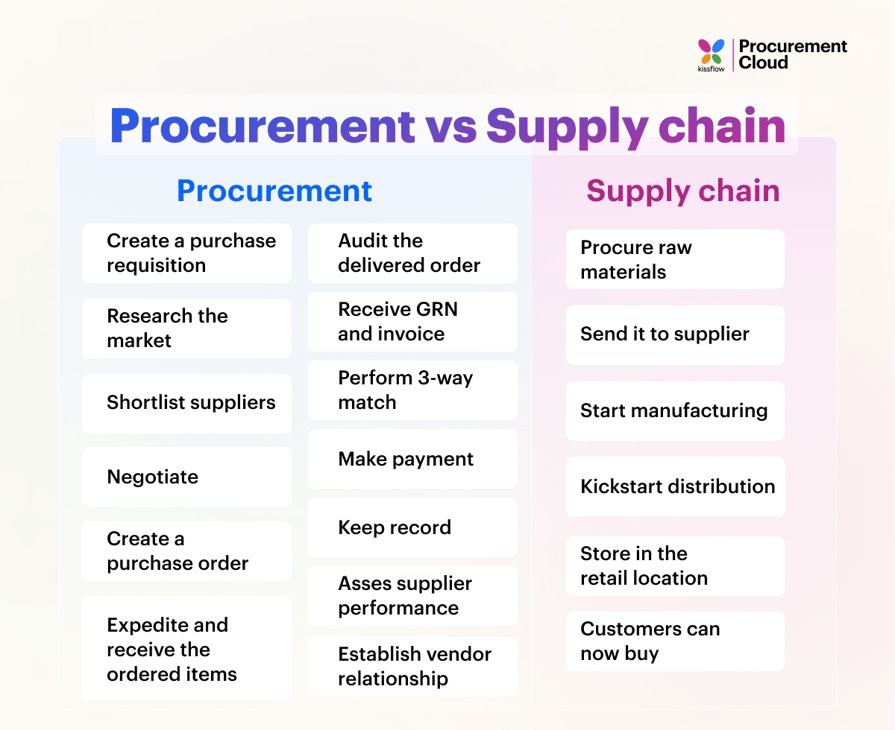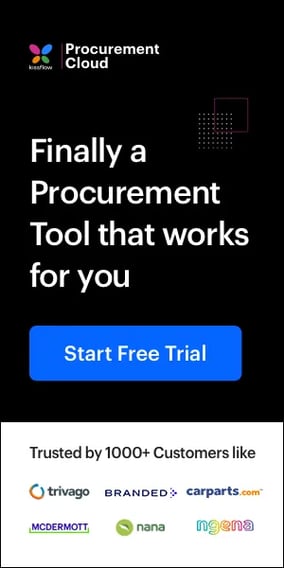Purchasing. Product acquisition. Procurement. You would’ve heard these buzzwords often and they seem quite similar. After all, on the surface procuring, acquiring, and purchasing seem like one and the same task, right?
Not exactly. In reality, they’re all different concepts in the procurement field that you need to get a good grip on to build and run a sustainable procurement machine.
In this article, we’ll dive into:
- What is procurement and how it works?
- What is supply chain management and how it functions
- The key differences between them, and
- How and when to determine which approach to take for your organization
Understanding how procurement and supply chain management both function will help you build a resilient, sustainable organization that can stay unmoved and exceed your customers’ expectations always.
What is procurement?
Procurement is the sum total of effort that goes into discovering and acquiring the supplies an organization requires to function effectively. This includes sourcing for supplies, sealing contracts, managing suppliers, and settling supplier invoices as and when due.
Ebook: Looking to automate procurement? Here's a step-by-step guide
Unlike how similar it sounds, procurement goes far beyond just purchasing supplies needed to run your organization’s day-to-day operations. Rather, procurement is concerned with what happens end-to-end, from the moment an organization determines a supply is needed until the required infrastructure to deliver and keep delivering it is made available.
To that end, procurement comprises several branches required to get supplies from suppliers to your organization’s doorstep, such as:
- Sourcing for vendors
- Estimating demand
- Determining quality standards and technical specifications
- Negotiating prices
- Contract management
- Acquiring goods and services
What is a supply chain?
The supply chain is the network of manufacturers, suppliers, logistics providers, and others who work together to get your product into the hands of a client. Not only do raw material providers, transportation businesses, and wholesale warehouses make up the supply chain, but so do jobs and services that help move the product. These responsibilities include quality assurance, marketing, procurement, and sourcing.
The supply chain of a company would, understandably, differ depending on the items or services it sells. It’s also crucial to note that procurement is only one aspect of the supply chain management process.
What is supply chain management?
Supply chain management is the art of managing all the relevant factors to get your products into your end users’ hands as efficiently as possible.
Ebook: Learn how to source strategically to save big on procurement
Supply chain management is about optimizing your supply chain so it runs as smoothly as possible, eliminating friction, and ensuring the entire process of producing goods or services, all the way to delivering them to the end-users functions seamlessly.
Explore more about kissflow's logistics management software.
Differences between procurement and supply chain management
To recap, procurement is the process of acquiring the supplies you need to run your business operations.
On the other hand, supply chain management encompasses how those supplies are transformed into finished products and delivered to the end-users.
Here are some of their key differences.

Procurement emphasizes on input; supply chain management focuses on output and delivery
While procurement has an input focus, supply chain management is more output-oriented and deals with what it takes to get your products and services into the hands of your customers as efficiently as possible.
Procurement deals with acquiring supplies; supply chain management encompasses all that and more
Procurement can be seen as a microcosm within the wider macrocosm, supply chain management.
While procurement only emphasizes building supplier relationships and managing them to ensure they can be leveraged to deliver the supplies your organization needs to function, supply chain management includes all that into its big bracket.
As it stands, procurement exists as a branch of supply chain management since it assists in getting the inputs that get processed into finished products.
Procurement supports production; supply chain management encompasses production and distribution
Procurement exists as a very significant support function within the business management equation as it’s essentially only concerned with ensuring the constant flow of the supplies an organization needs to process into finished products.
Supply chain management, on the other hand, is the main function that is supported by procurement.
In essence, supply chain management deals with how supplies are transformed into finished goods and distributed to the customers.
Supply chain management is all-encompassing, while procurement exists to support it with the input it needs to work.
Similarities between procurement and supply chain management
Judging by the insights we explored already, we can understand three key factors:
- Procurement supports your business functions by offering the inputs you need to run day-to-day operations
- Supply chain management deals with how those inputs are transformed into finished goods and delivered to your customers
- Procurement exists as a branch within supply chain management—it all boils down to getting goods to buyers
Despite their differences, both procurement and supply chain management are quite similar in many ways.
Here’s a breakdown of the similarities between procurement and supply chain management.
- Both procurement and supply chain management assist in delivering your business goals and targets
- Supply chain management and procurement are both internal operations; they may require input from external stakeholders but their core still remains within your organization
- Procurement and supply chain management has to be managed proactively in order to support your business operations
In conclusion, if you’re ever going to make sense of both your procurement and supply chain management, you need a tool designed for just that.
More specifically, you need a tool that’s built with an understanding of the differences between procurement and supply chain management.
That’s the only way you’ll be able to manage both optimally without lapses.
Using Kissflow Procurement Cloud, you can:
- Source, onboard, and engage suppliers from a huge pool
- Simplify purchasing with product catalogs
- Manage your internal production process with our project management tools
- Manage suppliers, distributors, and logistics from a single tool,
- Support countless supplier payment options, and finally,
- Bring all your procurement into one source of truth.
Kissflow Procurement Software is designed for businesses of all sizes looking to untangle procurement and manage the numbers and files with clarity.
Your search for Procurement has landed you here. Wondering why?
As a user, you'll experience the full value of Kissflow by implementing it across departments for diverse use cases rather than just addressing isolated needs like a project management tool for a single team or department.
Application Development Platform
Digital Transformation Platform
Find out more about the benefits of the Kissflow Low-Code Development platform




